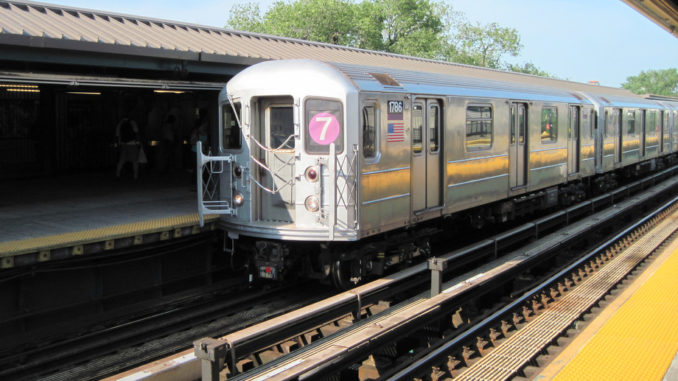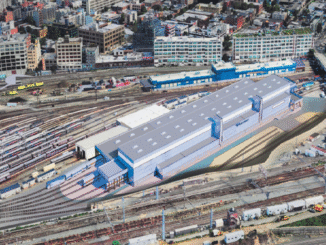
In the wake of announcement that LaGuardia will be rebuilt from ground up, MTA Chairman and Chief Executive Officer Thomas F. Prendergast asked New York City officials to provide $3.2 billion in support for the the agency’s capital program.
In a letter to New York City Mayor Bill de Blasio, Prendergast noted “we want a public transit system that is safe and reliable; one that meets the daily needs of its millions of riders and one that is poised to meet future needs.”
Prendergast’s complete letter is below:
July 28, 2015
Dear Mayor de Blasio:
I am writing in response to your comments regarding the appropriate level of City support for MTA capital needs.
Yesterday, in announcing his plan for a new LaGuardia Airport, Governor Cuomo publicly accepted the MTA’s request for the State to fund $8.3 billion for the Capital Program to be paid for through the state budget process over the next five years. He also voiced his support for what could be, with my requested $3.2 billion from the City, the largest Capital Program ever approved for the maintenance, improvement and expansion of the vital MTA system.
Given the State’s clear commitment and the need for the MTA to meet unprecedented challenges, we urge the City to stand up for our customers and your constituents by committing to provide $3.2 billion in support for the Capital Program. We believe our proposal is fair and appropriate.
As you know, the MTA’s assets total $1 trillion, with 80%—¬¬some $800 billion—dedicated to New York City Transit and directly benefitting New York City to a far greater degree than other parts of the MTA service area. These NYCT assets include some of those most expensive to maintain, including tunnels, 468 stations and more than 700 miles of track providing both local and express service for the same fare—key reasons why New York City is a global city comparable to no other.
As to the assertion that the State runs the MTA and the City’s representation is not adequate, I should note that of the 17 voting members of the MTA Board, four are designated by the Mayor and six by the Governor. When the City faced its financial crisis and lacked the resources to restore a crumbling system, the MTA brought it back from the brink of collapse, restoring ridership and rebuilding it into one of the best and most extensive public transit systems in the world. And while the City fiscal crisis that necessitated the State provide the majority of the MTA’s public funding has long passed, we have never recalculated the responsibility for financing an authority that principally serves the city. Today, the City has greater surplus funds than the State.
We are also concerned that the public might be misled by the suggestion that New York City government is already paying more significantly toward MTA operating costs or that the need for recurring capital investment on a large scale is, as First Deputy Mayor Shorris suggested, “a reflection of the failure of the MTA governance model.” MTA revenues from New York City residents who use the system are substantial for the obvious reason that use of MTA services is profoundly greater in NYC than in other parts of the MTA service area. To illustrate, trips on NYC Transit, Staten Island Railway and MTA Bus services average 300 trips per resident per year. For the commuter railroads, the intensity of use is less than one-tenth that…just 29 trips per resident on average.
Furthermore, New York City residents receive direct benefits from the MTA that other counties in the service district do not, including MTA para-transit services, student fares and senior fare discounts—and not without significant cost to the MTA. The City subsidizes $129 million of the cost of paratransit services, leaving the MTA to cover the remaining $270 million deficit. The City’s reimbursement of the discounted school fare program is $45 million, a small fraction of the $240 million total annual cost of that service. (The State and MTA pick up the remaining $195 million.) The City’s subsidy of the half-fare that the MTA provides to the City’s seniors has remained flat at $13.8 million since 1978, leaving the MTA to fund the remaining $95 million.
And, as the Independent Budget Office and Straphangers Campaign recently pointed out, the $325 million annual capital contribution we suggested the City should provide (in addition to the non-federal share of the costs of the Second Avenue Subway to East Harlem) would merely bring the city’s share to approximately what it would be had it kept pace with inflation for the past twenty years.
And, contrary to recent assertions, the fares for the MTA’s commuter rail customers are not subsidized to a significantly greater degree than fares for services to NYC riders. This year, the MTA Farebox Recovery Ratio, which captures current and long-term costs, shows that fares cover 37% of the cost of a subway or bus ride compared to the 36% average recovery of a Metro-North Railroad or Long Island Rail Road fare.
The direct City aid to the MTA’s operating costs in 2015 is $1.88 billion, or 27%. State subsidies will total $4.73 billion or 69%.
It is my view that the MTA, an independent authority created by the State and operating with a governance structure that has seen minimal change since its origins in the late 1960s, has well served both the City of New York and the MTA region.
In other words, we believe that the MTA governance model and New York City’s representation in MTA decisions have over the decades worked very much to the City’s benefit.
Finally, I have read that the City may pursue funding strategies that were not politically feasible in the past and are not likely politically feasible now. Pursuing these strategies would likely cause further delay and leave the MTA exactly where we are today one year from now.
I believe, Mayor, that both the City and the MTA share common goals. We want a public transit system that is safe and reliable; one that meets the daily needs of its millions of riders and one that is poised to meet future needs. We want a system that is affordable for its customers, recognizing the critical role that affordable transit plays in upward mobility; a system that fairly and equitably treats a diverse ridership throughout the region it serves. However, because every transit system depends on public subsidy, we want an MTA whose finances are stably grounded on subsidies that are fair to the City, State and customers. I believe all of these goals are reflected in our proposal and I look forward to a significant City commitment.
Sincerely,
Thomas F. Prendergast
Chairman and Chief Executive Officer





